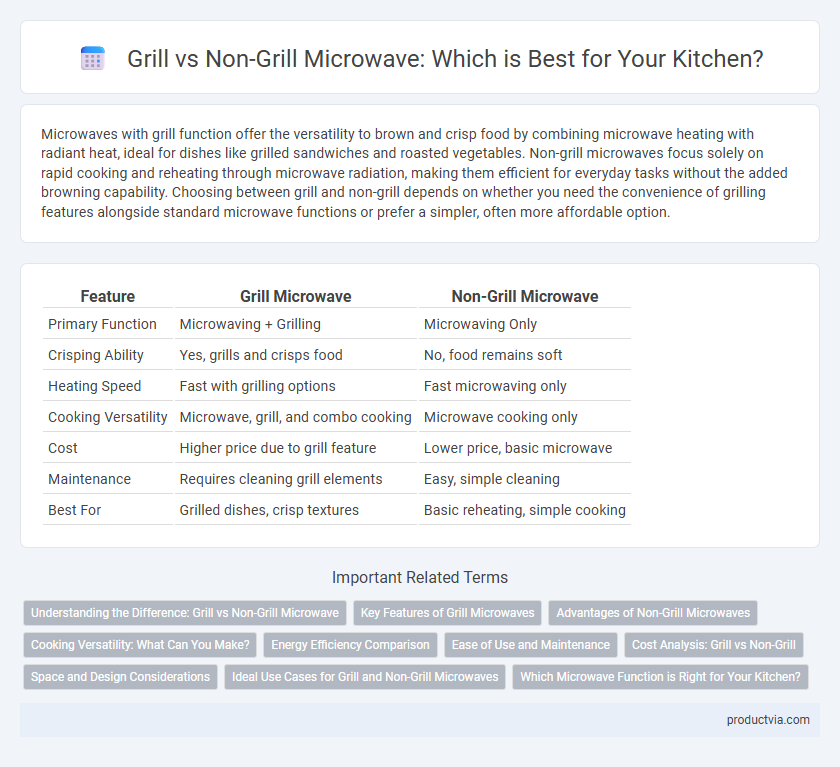Microwaves with grill function offer the versatility to brown and crisp food by combining microwave heating with radiant heat, ideal for dishes like grilled sandwiches and roasted vegetables. Non-grill microwaves focus solely on rapid cooking and reheating through microwave radiation, making them efficient for everyday tasks without the added browning capability. Choosing between grill and non-grill depends on whether you need the convenience of grilling features alongside standard microwave functions or prefer a simpler, often more affordable option.
Table of Comparison
| Feature | Grill Microwave | Non-Grill Microwave |
|---|---|---|
| Primary Function | Microwaving + Grilling | Microwaving Only |
| Crisping Ability | Yes, grills and crisps food | No, food remains soft |
| Heating Speed | Fast with grilling options | Fast microwaving only |
| Cooking Versatility | Microwave, grill, and combo cooking | Microwave cooking only |
| Cost | Higher price due to grill feature | Lower price, basic microwave |
| Maintenance | Requires cleaning grill elements | Easy, simple cleaning |
| Best For | Grilled dishes, crisp textures | Basic reheating, simple cooking |
Understanding the Difference: Grill vs Non-Grill Microwave
Grill microwaves feature a built-in heating element that browns and crisps food, making them ideal for grilling meats, toasting bread, and baking dishes with a crunchy top. Non-grill microwaves rely solely on microwave radiation to heat and cook food quickly but do not provide the grilling or browning effect. Choosing between grill and non-grill microwaves depends on the cooking versatility needed, with grill models offering more options for texture and appearance.
Key Features of Grill Microwaves
Grill microwaves combine microwave heating with a built-in grill element, enabling browning and crisping of foods for enhanced texture and flavor. Key features include a grill rack, multiple cooking modes, and adjustable power settings for versatile cooking options like grilling, roasting, and reheating. These microwaves often offer convection capabilities, providing faster cooking times and a broader range of recipes compared to non-grill microwaves.
Advantages of Non-Grill Microwaves
Non-grill microwaves excel in faster and more even cooking by utilizing microwave radiation without the need for additional heating elements, reducing energy consumption. They offer greater safety with fewer burn risks and simpler maintenance since there is no grill component to clean or replace. Ideal for reheating, defrosting, and simple cooking tasks, non-grill microwaves provide a cost-effective, user-friendly option for everyday kitchen use.
Cooking Versatility: What Can You Make?
Microwaves with grill function offer enhanced cooking versatility, enabling you to brown, crisp, and grill foods like chicken breasts, vegetables, and sandwiches, providing textures similar to traditional grilling. Non-grill microwaves primarily focus on reheating and defrosting, limiting options to steam-cooked and microwave-safe recipes without the ability to achieve crispy or browned finishes. Choosing a microwave with grill functionality expands your culinary repertoire by combining quick heating with grilling capabilities for more diverse meal preparation.
Energy Efficiency Comparison
Grill microwaves typically consume more energy than non-grill models due to the additional heating elements required for grilling, which increases power usage. Non-grill microwaves are generally more energy-efficient, using microwave radiation alone to cook or heat food, resulting in lower electricity consumption. Choosing a non-grill microwave can reduce energy costs and environmental impact while still providing effective heating performance.
Ease of Use and Maintenance
Microwaves with grill function offer the advantage of browning and crisping food, but typically require more frequent cleaning due to grease buildup on the grill element. Non-grill microwaves are simpler to maintain with fewer components to clean and are generally easier to operate for basic reheating and defrosting tasks. Ease of use in non-grill microwaves appeals to users seeking straightforward operation without the need for additional maintenance associated with grilling features.
Cost Analysis: Grill vs Non-Grill
Grill microwaves generally cost 20-30% more than non-grill models due to added heating elements and enhanced cooking versatility. Non-grill microwaves are more budget-friendly and energy-efficient, primarily suited for simple reheating and defrosting tasks. Investment in grill microwaves offers better value for users requiring browning or crisping functions, balancing higher upfront costs with multifunctional benefits.
Space and Design Considerations
Grill microwaves typically require more internal space to accommodate the heating element and fan system, leading to a bulkier design that might limit countertop or cabinet placement. Non-grill microwaves offer a more compact and streamlined form factor, making them ideal for kitchens with limited space or minimalist aesthetics. Choosing between grill and non-grill models depends on balancing cooking versatility with available installation area and design preferences.
Ideal Use Cases for Grill and Non-Grill Microwaves
Grill microwaves excel in browning and crisping food, making them ideal for cooking items like pizza, grilled sandwiches, and roasted vegetables that benefit from a crispy texture. Non-grill microwaves are best suited for reheating, defrosting, and cooking soups or steamed dishes where even heating without a crispy finish is desired. Choosing between grill and non-grill microwaves depends on whether the primary need involves crisp cooking or simple heating tasks.
Which Microwave Function is Right for Your Kitchen?
Grill microwaves combine microwave heating with a grill element to brown and crisp food, making them ideal for roasting or baking dishes like chicken or vegetables. Non-grill microwaves focus solely on microwaving, providing quicker heating and defrosting but lacking the ability to create crispy textures. Choosing the right microwave depends on whether you prioritize quick reheating and defrosting or the versatility to grill and toast food within one appliance.
Grill vs Non-Grill for microwave function Infographic

 productvia.com
productvia.com